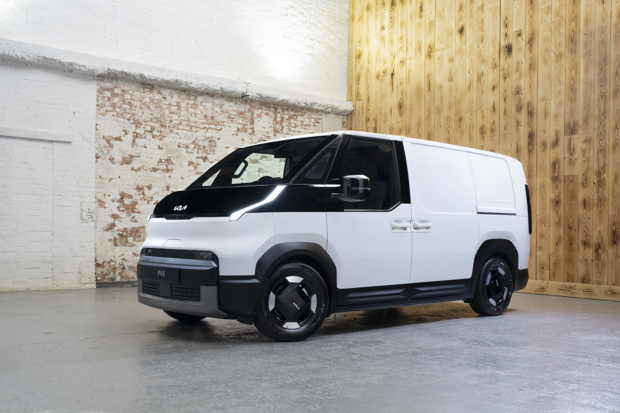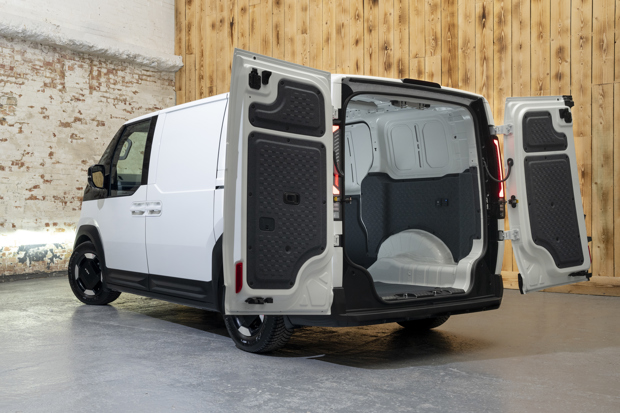Kia announces pricing as PV5 van order books open

Kia has launched its new PV5 electric van with an aggressive pricing strategy that sees the L1H2 version of the new van staring from £27,645 +VAT but before Plug-in Van Grant (PiVG).
The PiVG brings the total cost of the entry-level van down to as little as £22,645, making it look like strong value against smaller, similarly priced rivals.
For the UK market, the Kia PV5 will be offered in two lengths and two heights, with two battery options and two trim grades, depending on body type.
There will be three main commercial body types: Cargo, Crew and Chassis Cab. A Passenger variant is also offered, as well as a Wheelchair Accessible Vehicle (WAV) derivative.
The van will initially be available only in L2/H1 form across Cargo and PV5 Crew and L2 for PV5 Chassis Cab. PV5 Cargo L1/H1 and L2/H2 will follow in 2026.
There will be two trim levels Essential and Plus. In addition, a choice of two battery packs will be offer. The standard range 51.5kWh battery pack provides a greater payload due to being lighter in weight, while the long range 71.2kWh battery pack adds range but reduces cargo payload.
The lighter standard range 51.5kWh battery pack is powered by a single electric motor powering the front wheels and outputting 89.4kW. The long range battery pack is also front-motor front wheel drive only, with an output of 120kW. The standard range model offers a range of 174 miles and the long range 217 miles.
All PV5 variants offer 400V fast charging capability, meaning when connected to a 150kW charging point the PV5’s battery (both standard range or long range) can be topped up from 10-to-80% in less than 30 minutes.
The L1H2 offers a cargo volume of 4.4 cubic metres, which allows for two standard euro-pallets to be accommodated. Maximum payload is 790kg for the standard range battery, while the long range battery has a 690kg payload. Cargo volume increases to 5.1 cubic metres for the L2/H2 or decreases to 4.0m3 for the L1/H1 - more information on these models will be made available in 2026.
As standard, the PV5 Cargo comes as a 3-door vehicle, featuring two cab doors and a single sliding door on the nearside to access the cargo area. An optional offside sliding door can be added. All PV5 Cargo variants come with a split rear door opening featuring detachable hinges.
The crew van features a rear bench seat, with a payload of 605kg, while the cargo area offers storage capacity between 2.4 and 3.7 cubic metres.
Details and pricing for the PV5 Chassis Cab, along with a range of approved conversions, will be made available later this year.
The interior is a two-seater only, finished in dark blue cloth. There is a 12.9-inch touchscreen display powered by Android Automotive OS, which supports wireless Apple CarPlay and Android Auto, plus a 7.5-inch digital instrument display.
The low chassis sees Kia claim a best-in-class low cargo load height of 419mm at the rear, measured from the ground, with a tight turning circle of 10.8 metres.
All Kia PV5 variants will come with a seven-year/100,000-mile warranty as standard, plus an eight-year warranty on the high voltage battery.
Pricing starts from £27,645 (+VAT) for the PV5 Cargo ‘Essential’ with standard range battery, rising to £30,145 (+VAT) with long range battery. In addition, PV5 Cargo will qualify for the current Office for Zero Emission Vehicles (OZEV) Plug-in Van Grant (PIVG) that further reduces the price by up to £5,000.
Kia PV5 Cargo pre-orders begin now, with first UK customer deliveries starting in late 2025. Other PV5 Cargo variants, as well as PV5 Crew and PV5 Chassis Cab, pricing will be revealed later this year.


